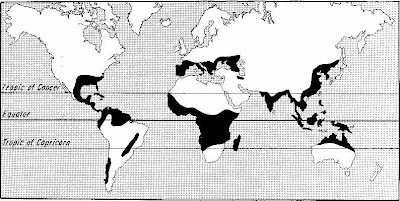
When we think of parasites, the image that often comes to mind is that of something monstrous, lurking in the shadows, ready to take over. Well, one of the more unassuming yet fascinating parasites out there is the whipworm. Found in various corners of the globe, these tiny creatures might not look like much, but they play a significant role in understanding human and animal health. Think of whipworms like the misunderstood underdogs of the parasite world; they’re small, but they make a big impact.
Let me break it down for you. Whipworms are helminths, specifically from the genus Trichuris. Just like a whip, their slender bodies can reach lengths of up to 5 centimeters, yet they can cause some serious health issues for their hosts, particularly in underdeveloped regions. But where exactly do these little guys live? In this article, we’ll dive into the documented range and distribution of whipworm worldwide, exploring where they thrive and why this is important.
What Are Whipworms?
Whipworms belong to the class of parasites known as nematodes. Imagine them as tiny, serpentine creatures living snugly within the intestines of their hosts. They have a distinctive whip-like tail, which is precisely how they got their name. Whipworms primarily infect humans and are responsible for whipworm infections, which can lead to serious gastrointestinal issues.
These nematodes are generally transmitted through contaminated soil or food. When a person ingests eggs present in this contaminated environment, the eggs hatch within the intestine and mature into adult whipworms. They can live for years, quietly making themselves at home while causing problems for their hosts.
Here’s a fun fact: whipworms are particularly adept at surviving in harsh conditions, which is why they can be found in a variety of environments across the world.
The Global Distribution of Whipworm
Whipworm prevalence is largely concentrated in developing countries, particularly in tropical and subtropical regions. You might be wondering where exactly these little parasites are most often found. According to studies, whipworms are primarily documented in parts of Africa, Asia, and Latin America, with a significant presence in areas with poor sanitation and hygiene practices.
In Africa, countries such as Nigeria and Tanzania report high cases of whipworm infections. Similarly, Southeast Asian nations like Indonesia and the Philippines also see these parasites frequently. They thrive in warm, humid environments where sanitation isn’t optimal.
Interestingly, whipworm infections are much less common in developed nations. This can be attributed to better sanitation practices and public health interventions. It’s a reminder of how global health can be so intertwined with economic and social factors.
Factors Influencing Whipworm Distribution
So, what factors influence where whipworms can live and thrive? First, let’s talk about environmental conditions. Whipworms need warm, moist environments to survive. Areas with heavy rainfall and tropical climates provide ideal living conditions for their eggs.
Next, consider sanitation. Poor hygiene practices contribute significantly to the spread of whipworm infections. In densely populated areas where waste management isn’t prioritized, the risk of contamination increases. This creates a vicious cycle where the presence of whipworms exacerbates health issues, further hindering community development.
Also, socio-economic factors play a huge role. In communities where access to healthcare is limited, people might not receive proper treatment, allowing whipworms to continue their lifecycle uninterrupted. It’s a tough reality that underscores the importance of public health efforts.
Health Impacts of Whipworm Infections
Let’s get a bit serious for a moment and look at the health impacts of whipworm infections. Whipworms can cause a range of gastrointestinal issues, from mild discomfort to severe symptoms like anemia and malnutrition. For children, this can be especially detrimental, impacting growth and cognitive development.
In many cases, whipworm infections can lead to chronic diarrhea, abdominal pain, and even rectal prolapse in severe situations. The situation becomes even more troubling because these symptoms can severely affect a person’s ability to perform daily tasks, from school to work.
Interestingly, while whipworm infections are often viewed negatively, some studies have suggested that these parasites might play a role in certain immune responses. It’s a complex relationship that’s still being explored, but it shows just how intricate the balance between humans and parasites can be.
Prevention Strategies
Preventing whipworm infections largely revolves around improving hygiene and sanitation. You might wonder what that looks like on the ground. Here are a few strategies that have shown success:
- Education: Raising awareness about the importance of handwashing and personal hygiene can significantly help reduce infections.
- Improved Sanitation: Investing in better waste management systems is crucial. When waste disposal is managed properly, the risk of environmental contamination goes down.
- Regular Deworming: Implementing community-wide deworming programs can help reduce the prevalence of whipworm, particularly in schools with children.
These strategies not only target whipworms but also address other soil-transmitted helminths, making communities healthier overall. By taking active steps, we can create a safer environment for everyone.
The Future of Whipworm Research
As we wrap up, it’s essential to consider the future of whipworm research. Scientists are continually studying these little creatures to better understand their life cycles, transmission, and impacts on health. You might be curious about why this matters. Well, shedding light on whipworms can lead to better treatment options, management strategies, and even potential eradication efforts.
With ongoing research, there’s hope that we’ll find innovative solutions to combat whipworm infections and improve the quality of life for millions affected by these parasites. The more we understand about whipworms, the better equipped we are to address their impact on global health.
In conclusion, whipworms may be small, but their impact can be significant. By understanding their range and distribution, along with the factors affecting their prevalence, we can take steps toward a healthier future. Keeping these little creatures in check is an essential part of improving health on a global scale.
